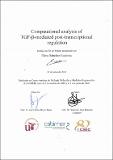Por favor, use este identificador para citar o enlazar a este item:
http://hdl.handle.net/10261/230817COMPARTIR / EXPORTAR:
 SHARE
BASE SHARE
BASE
|
|
| Visualizar otros formatos: MARC | Dublin Core | RDF | ORE | MODS | METS | DIDL | DATACITE | |

| Título: | Computational analysis of TGF-β-mediated post-transcriptional regulation |
Otros títulos: | Estudio genómico de la regulación postranscripcional mediada por TGFbeta | Autor: | Sánchez-Escabias, Elena CSIC | Director: | Reyes, José C. CSIC ORCID | Palabras clave: | Chromatin-enriched RNA-seq (ChRNA-seq) Genomics Post-transcriptional regulation RNA sequencing (RNA-seq) RNA splicing Splicing Index of the Gene (SIG) Transcriptomics Transforming growth factor beta (TGF-β) |
Fecha de publicación: | 18-jun-2020 | Editor: | Universidad de Sevilla CSIC-JA-UPO-USE - Centro Andaluz de Biología Molecular y Medicina Regenerativa (CABIMER) |
Resumen: | Bioinformatic approaches have increased their relevance in the latest years, being computational analysis a crucial tool for genomics and transcriptomics. To better understand how transforming growth factor beta (TGF-β) influence post-transcriptional regulation and RNA splicing we performed a wide computational analysis comparing RNA sequencing (RNA-seq) and Chromatinenriched RNA-seq (ChRNA-seq) data provided by Dr. Reyes’ group. TGF-β provoked changes in both nuclear and cytoplasmatic post-transcriptional regulation being the cytoplasmatic component crucial to gene expression direction. Thus, a positive (or negative) change in cytoplasmatic posttranscriptional regulation affect gene expression in the cell. In order to investigate splicing efficiency at the whole gene level we created the Splicing Index of the Gene (SIG) parameter. Genes with high SIG were characterized by high exon signal, a few reads in intronic regions and were less expressed in the nucleus. On the contrary, genes with low SIG were more expressed and had similar signal in exonic regions than in the intronic. Differences of SIG between genes were related to gene length and splicing site sequences. We observed a rough positive correlation between splicing efficiency and gene length, so we developed a model based on co-transcriptional nature of splicing where RNA polymerase II (RNAPII) would pass rapidly through the short gene, being all introns incapable to be matured, whereas in long genes, with long introns, spliceosome would have time to remove all introns from the pre-mRNA | URI: | http://hdl.handle.net/10261/230817 |
| Aparece en las colecciones: | (CABIMER) Tesis |
Ficheros en este ítem:
| Fichero | Descripción | Tamaño | Formato | |
|---|---|---|---|---|
| DIRECCION_DE_TRABAJOS827462_VAL.pdf | 2,71 MB | Adobe PDF |  Visualizar/Abrir |
CORE Recommender
Page view(s)
129
checked on 21-abr-2024
Download(s)
120
checked on 21-abr-2024
Google ScholarTM
Check
NOTA: Los ítems de Digital.CSIC están protegidos por copyright, con todos los derechos reservados, a menos que se indique lo contrario.
